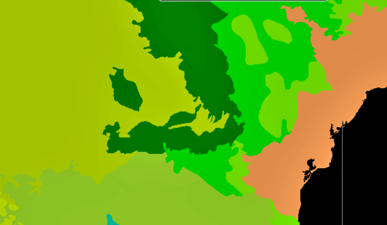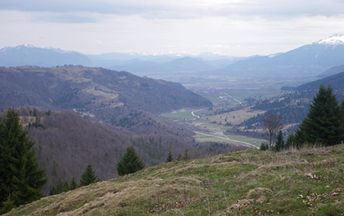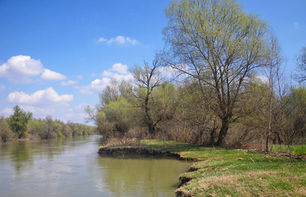Ecoregions of Romania
The chief ecoregions of Romania include: Carpathian montane conifer forests; Pannonian mixed forests; Central European mixed forests; Pontic-Caspian steppe (including part of the Danube Delta). In addition, to these large patch ecoregions, the Black Sea coastal regionrepresents a specialized littoral, dunes and marsh system of very narrow extent along the Black Sea coastline.
 Ecoregions of Romania, Source: WWF
Ecoregions of Romania, Source: WWF
The only large scale intact habitats of the country of Romania are found in the Carpathian montane conifer forests, where rugged slopes have deterred agricultural conversion, and in the richly braided Danube Delta, where the river mouth area is particularly inaccessible and undisturbed.
The Carpathian montane conifer forests are one of the few regions of Europe where wolves and bears are evident; their remarkable protection is due not only to the rugged terrain that has limited human activity, but also due to the area's pastoral history, where alpine shepherds have integrated their style of flock-tending with compatible existence of mammalian predators, through the use of sheep guard dogs and other protocols.
Contents
Carpathian montane conifer forests
While the Carpathian Mountains form an arc across Central and Eastern Europe, the Carpathian montane conifer forests (PA0504, as designated by the World Wildlfe Fund) within Romania produce a sub-arc almost surrounding the Transylvania Plateau in northern Romania. The steeply sloped forests provide habitat for the largest populations in Europe of brown bear, wolf and lynx, as well as over one third of all European plant species. The Carpathians are a vital watershed for Central Europe, feeding the major rivers of this region. A bridge between Europe’s northern and southwestern forests, the range serves as a biological corridor for the dispersal of plants and animals throughout Europe. Though approximately 16% of the ecoregion is under some form of protection, logging, hunting, and development threaten to break this critical link.
 Carpathina montane forests from a ridge in Piatra Craiuli NP. @ C.Michael Hogan
Carpathina montane forests from a ridge in Piatra Craiuli NP. @ C.Michael Hogan
Plant associations of the Carpathians manifest a distinct zonation: the foothills are chiefly dominated by mixed deciduous forests, featuring pedunculate oak (Quercus robur), and hornbean (Carpinus betulus) in the north. The montane zone, between 600 and 1100 m in the north and between 650 and 1450 m in the south, is dominated by two major species: European beech (Fagus sylvatica) and silver fir (Abies alba). Nearly pure beech forests dominate the montane zone in some mountain ranges in the Southern Carpathians. In most areas beech is mixed with silver fir, Norway spruce (Picea abies), and sycamore (Acer pseudoplatanus). In some places the montane zone is dominated by conifers, usually a mixture of Silver fir and Norway spruce. The subalpine zone (1100-1400 m in the north, 1400-1900 m in the south) consists of almost pure Norway spruce forests, with a small admixture of rowan (Sorbus aucuparia). Stone pine (Pinus cembra) occurs at the alpine timberline in the highest reaches of the F?g?ra? Mountains. Above timberline, (1400 m in the northwestern Carpathians to 1900 m in the south), there is a distinct krummholz zone consisting of dense thickets of mountain pine (Pinus mugo), dwarf juniper (Juniperus communis subsp. nana) and green alder (Alnus viridis). Above the krummholz zone occur lush alpine meadows, except on the highest peaks in the F?g?ra?, which are mostly rocky or covered with very sparse alpine vegetation.
The Piatra Craiului National Park is one of the major protected areas within the Carpathian montane forests. The rugged terrain within this national park provides inherent protection for considerable amounts of relatively pristine forests and the bear, wolf and other animal populations within these forests.
Pannonian mixed forests
The Pannonian mixed forests(PA0431) represent a broad plateau area surrounded by the Carpathian arc. This ecoregion occupies a relatively small part of Romania, and strictly lies in the extreme western central portion of the country. Resident mammals include the European rabbit (Oryctolagus cuniculus), wolf (Canis lupus), and the endangered European mink (Mustela lutreola). There are a number of endangered reptiles including Orsini's viper and Balkan wall lizard.
Central European mixed forests
The Central European mixed forests (PA0412) in Romania are dominated by pine, oak, and hornbeam species. This ecoregion occupies a relatively small area of northeastern Romania. Centuries old transformation created a range of semi-natural habitats (like extensively used meadows and traditional pastures) which now harbour a vast array of plant and animal species diversity. That diversity is now threatened by the changes in land use pattern, namely by more intense management in some areas, and abandonment of traditional management (associated with secondary succession) in others. Agriculture, urban development, irrigation, road construction, habitat fragmentation and deforestation are all significant ecological threats to this ecoregion.
East European forest steppe
The East European forest steppe (PA0419) acts as a transition ecoregion linking temperate broadleaf forests in the north with the Pontic-Caspian steppe to the south. This forest steppe ecoregion includes the lowland-colline subcontinental meadow steppes and dry grassland vegetation, and lowland-colline lime-oak forests spanning much of Eastern Europe. In Romania this forest steppe wraps around the east and south of the Carpathian arc.
Pontic-Caspian steppe
 Scene in the Danube Delta braided channels. @ C.Michael Hogan
Scene in the Danube Delta braided channels. @ C.Michael Hogan
Pontic-Caspian steppe (PA0814) is a vast steppeland extending from the Black Sea northern rim to the east of the Caspian Sea, from Romania at the western end. This ecoregion forms a portion of the larger Eurasian steppe next to the Kazakh steppe at the east. The Pontic-Caspian steppe ecoregion consists of the paleartic temperate grasslands, savannas, and shrublands biome. This ecoregion within Romania is converted largely to agricultural uses, including row crops and grazing lands. An important portion of the ecoregion is the lower right bank watershed of the Danube Delta.
Structural definition
Ecoregions are typically defined as geographical areas: (a) sharing a substantial majority of their species and ecological dynamics; (b) sharing similar environmental conditions; and, (c) interacting ecologically in ways that are vital for their long-term persistence. Scientists at the World Wildlife Fund have devised a classification system that divides the world in 867 terrestrial ecoregions, 426 freshwater ecoregions and 229 marine ecoregions that reflect the distribution of a broad range of fauna and flora across the entire Earth.
References
- Udo Bohn, Gisela Gollub, and Christoph Hettwer. 2000. Reduced general map of the natural vegetation of Europe. 1:10 million. Bonn-Bad Godesberg
- S.D.Davis, V.H. Heywood, and A. C. Hamilton. 1994. Centres of Plant Diversity. Vol. 1: Europe, Africa, Southwest Asia and Middle East. D.C.: WWF and IUCN.
- B.C.W.Delbaere, editor. 1998. Facts and figures on Europe's biodiversity - state and trends 1998-1999. Technical Report Series, ECNC. Tilburg, NL.
- S.Nehyba and J.Šikula. 2007. Depositional architecture, sequence stratigraphy and geodynamic development of the Carpathian Foredeep (Czech Republic). Geologica Carpathica, 58, 1, pp. 53-69
- Laura Riley and William Riley. 2005. Nature's strongholds: the world's great wildlife reserves. Princeton University Press, Princeton, New Jersey
